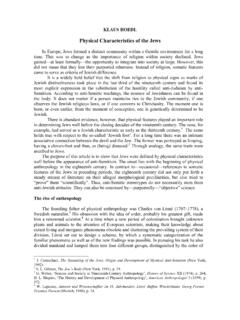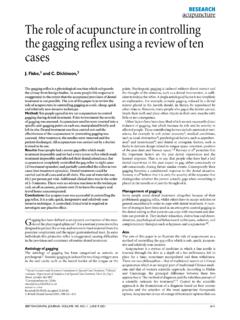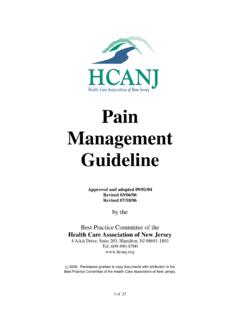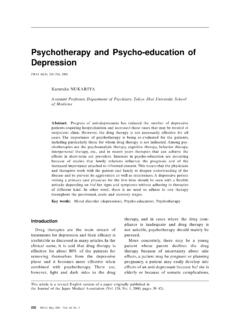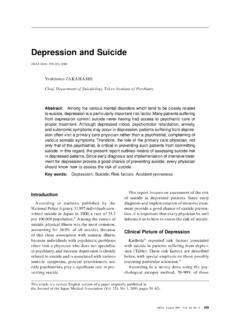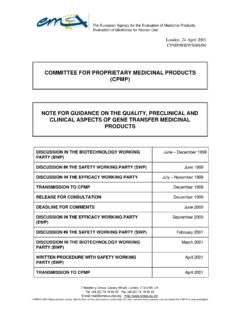Transcription of Interpretation of thyroid function tests
1 For personal use only. Reproduce with permission from The Lancet Publishing LANCET Vol 357 February 24, 2001619 There have been considerable improvements in assays forthyrotropin (TSH), free T4, and free T3 over the past 20years. As a result, Interpretation of thyroid function testsis now generally straightforward, and more than 90% ofpeople investigated are diagnosed with normal thyroidgland function . However, there remain a few situations inwhich the results of TSH, free T4, and free T3 assaystend to point in different directions, as well as cases inwhom thyroid function test results seem clear cut but arein fact misleading. Additionally, over the past 6 years, anincreasing number of genetic defects has been identifiedin the pituitary- thyroid axis. These defects are easilymisdiagnosed by the unwary and, although rare, canpresent for the first time in adulthood, with implicationsfor both the patient and their family.
2 My aim is to guidethe general physician around these pitfalls with a function testsThe choice of first-line thyroid function tests depends onlocal arrangements and laboratory protocols. In manylaboratories, a highly sensitive TSH assay (second or thirdgeneration, with a limit of detection <0 1 mU/L)1alone isused for initial screening, which is satisfactory so long asits limitations are appreciated. At an increased cost, thesensitive TSH measurement can be combined with asingle measurement of total or free thyroid hormoneconcentrations to address these limitations. T3 or T4estimation alone as an initial screen, however, will misssubclinical thyroid dysfunction and is not advised. If TSHis abnormal, a free T4 or, when TSH is low, a free T3assay should be obtained, and in difficult cases when thesuspicion of thyroid dysfunction remains high, acombination of all three tests (TSH, free T3, free T4) willusually avoid misdiagnosis.
3 Finally, total- thyroid -hormone assays are still used in some of the changes in thyroid -binding proteins,however, these tests can cause diagnostic confusion andshould be accompanied by a marker of protein bindingsuch as a T3 uptake assay. Since these issues have been reviewed,2I willLancet2001;357:619 24 University Department of Medicine, Bristol Royal Infirmary, BristolBS2 8HW, UK(C M Dayan FRCP)(e-mail: on diagnostic difficulties that persist evenwhen free-hormone assays, or assays corrected for proteinbinding, have been done. Note, however, that free-hormone assays by routine methods are still affected byextreme changes in binding-protein concentrations, non-thyroidal illness, and some drugs eg, recommendations for assay performance, takinginto account biological variation, include an imprecision(between-site) of less than 10% for all thyroid hormoneassays, and less than 20% for TSH assessed at the statedlower limit of ,3 Despite recent improvements,many assays fail to meet these criteria.)
4 Important bias alsoexists between commercial methods emphasising the needfor results to be compared with normal ranges derivedwith the same TSH alone is the first line test, what diagnoses will bemissed? Sensitive TSH assays are widely used andfinancially justifiable as first-line screening tests . However,they can be misleading when: hypothyroidism is caused bypituitary disease (TSH is usually in the normal range),4hypothyroidism develops within 12 months of treatmentfor thyrotoxicosis (the TSH value remains suppressed),5thyrotoxicosis is caused by a TSH secreting pituitarytumour,6or individuals are thyroid hormone resistant7(TSH is usually in the normal range in these final two)(panel 1). In these cases testing of free thyroid hormonesis recommended in addition to the TSH assay. However,a small number of unsuspected cases of secondaryhypothyroidism with undiagnosed secondaryhypoadrenalism will still be missed (estimated to be 1 in20000 of the population).
5 8 Non-thyroidal illness(previously termed the sick euthyroid syndrome) can alsoresult in low thyroid hormone concentrations with TSHvalues in the normal range, but clinically importantdiagnoses are unlikely to be missed in such additional thyroid tests should be routinelyavailable? tests enabling measurement of antithyroidperoxidase autoantibodies ( anti -TPO, previously referredto as thyroid antimicrosomal antibodies) are oftenvaluable when trying to determine the cause of a , assays for antithyroglobulinInterpretation of thyroid function testsColin M DayanReviewThe introduction of sensitive thyrotropin assays and free thyroid hormone measurements has simplified theinterpretation of thyroid function tests . However, important pitfalls and difficult cases still exist. In this review, thyroid function test results are grouped into six different patterns. We propose that if assays for thyrotropin, free T3,and free T4 are all done, knowledge of these patterns coupled with clinical details and simple additional tests allow adiagnosis to be made in almost all 1: Conditions in which TSH alone might be misleadingCommonRecent treatment of thyrotoxicosisPituitary diseaseNon-thyroidal illnessRareTSH-secreting pituitary tumourThyroid hormone resistanceFor personal use only.
6 Reproduce with permission from The Lancet Publishing , anti -TSH receptor antibodies, thyroxine-binding globulin, and thyroglobulin are only indicated inspecific circumstances, and need only be available inregional can thyroid dysfunction be confidently excluded?In clinical practice, six different patterns of the three mainthyroid function tests (TSH, free T3, free T4) are seen. Inindividuals with thyroid disease, or a strong clinicalsuspicion of thyroid disease, all three tests should be doneon at least one occasion so that a clear diagnosis can bemade. If all three are in the normal range, thyroid diseasecan be confidently excluded. The only exception to thisrule is individuals having thyroxine replacement, whocould possibly benefit from an increased dose of thyroxineor a combination of thyroxine and triiodothyronine evenwhen TSH, free T3, and free T4 are in the normallaboratory ,12 This area remains TSH, raised free T3 or T4 There are six patterns of thyroid function tests .
7 Low TSH,accompanied by raised free T4 and T3 concentrations(panel 2), indicates primary hyperthyroidism, mostcommonly caused by Graves disease, multinodulargoitre, or toxic nodule. In these cases TSH should beundetectable and thyroid tissue should not be criteria can usually separate the three commoncauses of primary hyperthyroidism, however, there is nodefinitive test for Graves disease. Thyroidophthalmopathy and a diffuse uptake on technetium orradioiodine thyroid scanning make the diagnosis ofGraves disease likely, but antithyroid antibodies(including anti -TSH-receptor antibodies) are negative inabout 10% of cases. Graves disease can also developduring recovery from profound anti -T-cellimmunotherapy,13and should, therefore, be suspected inthis unusual context. Amiodarone causes thyrotoxicosis inup to 10% of individuals treated, and can be difficult induced hyperthyroidism is rare as thisdrugs leads more often to the history of hyperthyroid symptoms is short(<1 month), response to antithyroid drugs is unusuallyrapid eg, euthyroidism is achieved within 2 weeks orhyperthyroidism is diagnosed in the postpartum period,transient thyroiditis should be suspected (subacute, silent,or postpartum).
8 16 Thyroiditis can be confirmed by a lowuptake on radioiodine or technetium thyroid scanning,and is important since thionamides are ineffective,symptomatic treatment ( blockers) alone usually beingsufficient in these conditions. Tenderness over the thyroidgland and a raised erythrocyte sedimentation rate suggestssubacute (postviral or De Quervain s) thyroiditis, but canalso indicate silent thyroiditis. Silent and postpartumthyroiditis17(the latter occurring within 9 monthspostpartum) are related autoimmune conditions, whichcan arise repeatedly,18and are sometimes, confusingly,painful. anti -TPO antibodies are on occasion detectableand can be useful, in the absence of histology, todifferentiate postviral and silent causesof thyrotoxicosis with a low radioiodine uptake includethyroxine ingestion (therapeutic or factitious), ectopicthyroid tissue (including struma ovarii), amiodaronetherapy, and excess iodine ingestion (typically seen inmultinodular goitre-Jod-Basedow effect).
9 16An increase inthyroid tissue favours the last pregnancy, pronounced biochemicalhyperthyroidism usually results from Graves disease, buta mild rise associated with vomiting in the first trimestercan be caused by overstimulation of the TSH receptor byvery high human chorionic gonadotropin concentrationsor human chorionic gonadotropin variants (gestationalthyrotoxicosis or molar pregnancy). Striking anti -TPO-negative thyrotoxicosis, which recurs in subsequentpregnancies and spontaneously resolves postpartum,raises the rare possibility of familial gestationalhyperthyroidism. In this recently identified condition, aK183 Rmutation in the TSH receptor increases its abilityto be activated by human chorionic possibility of a dominant germline activating TSH-receptor mutation exists in thyrotoxicosis that persistentlyrecurs after thyroidectomy, or treatment with radioiodine,and in patients with other family members, particularlychildren, cases are rare but the diagnosisis worth making, because it allows screening of otherfamily members and aggressive treatment (totalthyroidectomy plus radioiodine).
10 Affected individuals areanti-TPO negative. Age of onset varies from the neonatalperiod to adulthood, and a smooth or multinodular goitrecan ,21 Closely similar somatic mutations areresponsible for 80% of toxic TSH, normal free T3 or T4 Low TSH and normal free T3 and T4 test results areusually seen with thyroxine ingestion (panel 3). A lesscommon alternative is subclinical primaryhyperthyroidism, typically seen in elderly people. Furtherinvestigation normally reveals a multinodular goitre. IfTSH is wholly suppressed, this situation can requiretreatment since the risk of atrial fibrillation22andosteoporosis is patients in hospital, high-dose steroid ordopamine and dobutamine infusions, both of which cansuppress pituitary TSH release, or non-thyroidal illness9should be considered. Repeat thyroid function testsREVIEW620 THE LANCET Vol 357 February 24, 2001 Panel 2: Low TSH, raised free T3 or free T4 CommonPrimary hyperthyroidism:Graves diseaseMultinodular goitreToxic noduleRelatively common with low radioiodine uptakeTransient thyroiditis:PostpartumSilent (lymphocytic)Postviral (granulomatous, subacute, De Quervain s)Rare with a low radioiodine uptakeThyroxine ingestionEctopic thyroid tissue or struma ovariiIodine inducedAmiodarone therapyRare with a positive pregnancy testGestational thyrotoxicosis with hyperemesis gravidarumHydatidiform moleFamilial gestational hyperthyroidismRare familial or resistant to treatmentActivating germline TSH-receptor mutationPanel 3: Low TSH, normal free T3 or free T4 CommonSubclinical hyperthyroidismThyroxine ingestionRareSteroid therapyDopamine and dobutamine infusionNon-thyroidal illnessFor personal use only.

